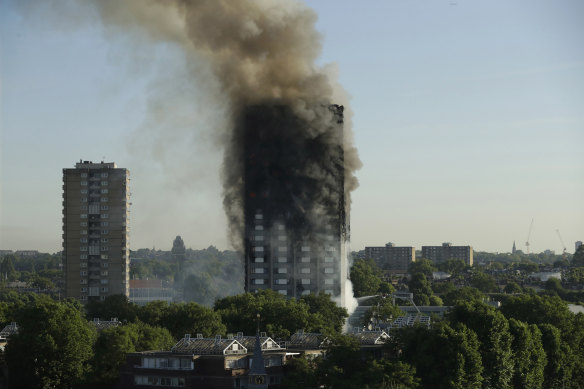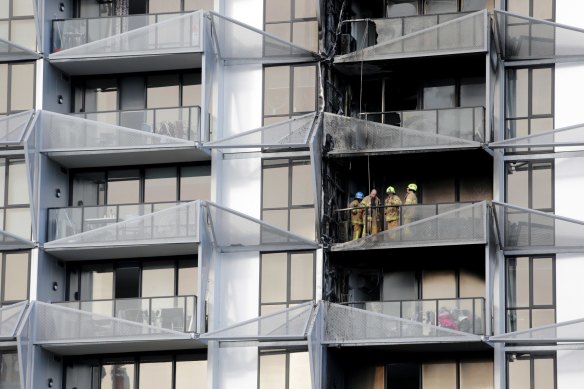This was published 2 years ago
Hundreds of buildings with cladding deemed low priority despite possible ‘unacceptable fire risk’
By Lucy Cormack
The state government taskforce into dangerous flammable cladding has deemed more than 500 buildings a low priority, despite their facades potentially posing unacceptable fire risks.
NSW Auditor-General Margaret Crawford made the finding in a review of reforms targeting unsafe cladding since the material supercharged London’s deadly Grenfell Tower fire tragedy in 2017.
Crawford said identification of buildings in the immediate aftermath was hampered by a lack of building records, but found the rate at which buildings are being added to the cladding register is falling.

The deadly Grenfell Tower fire in London in 2017.Credit:
Of 1200 apartment blocks, guesthouses and public buildings identified by councils for possible flammable cladding four years ago, at least half are yet to be assessed. Forty per cent have either been rectified or found not to pose an unacceptable risk.
The auditor-general’s review of the cladding taskforce found it only had a process for clearing high-risk blocks, which the government has estimated to cost about $4 million per building.
“The management of buildings assessed as low-risk ... estimated to be over 500, has not been a priority of the cladding taskforce to date, despite those buildings potentially posing unacceptable fire risks,” the report said.
Industry stakeholders say the audit highlights the need to ensure lower risk buildings are not left behind.
The audit, tabled to parliament on Wednesday, comes almost five years after the Grenfell fire, which claimed the lives of 72 people and exposed the dangers of flammable cladding.
Almost three years earlier cladding was also linked to a fire at Melbourne’s Lacrosse Tower, which was also fuelled by the combustible material.

A tribunal earlier this year found the consultant building surveyor, fire engineer and architect bore more liability for the use of combustible cladding on Melbourne's Lacrosse Tower than the builder. Credit: Wayne Taylor
Responding to Grenfell, the government launched a 10-point plan to identify high-risk buildings in NSW and formed the taskforce led by the Department of Customer Service.
Since then, around 50 per cent of government-owned buildings and almost 90 per cent of Department of Planning and Environment buildings have been cleared or cladding remediation is underway.
However, the auditor-general found information management by the government’s taskforce was inadequate in reliably tracking all buildings through the process, recommending improvements to accuracy by December this year.
Crawford also said there had been no enforcement of a ban on cladding with more than 30 per cent polyethylene content since it was introduced in 2018. Her recommendations include tightening the ban by October.
In a statement Minister for Fair Trading Eleni Petinos said she had asked the cladding taskforce to “make the recommended improvements, where possible”.
Opposition spokeswoman for innovation and better regulations Courtney Houssos said the audit showed the cladding response had been “slow and haphazard.“
“No work has been done on those buildings that were identified as low risk. This is just another symptom of the government’s failure to have a comprehensive and coordinated response,” she said.
“There’s been problems with providing apartment owners with certainty about what actually needs to be remediated right from the very beginning”.
Chris Duggan, president of peak body Strata Community Australia, said the government response to cladding had initially been a “scatter gun approach”, but that remaining gaps needed to be addressed.
“For high-risk buildings in the beginning it was obviously about prioritising rectification. But clearly stage two now is to make sure lower risk building don’t get left behind.”
In November 2020, the state government announced a three-year remediation program for high-risk apartment owners forced to replace flammable cladding, offering interest-free loans under the $1 billion program.
Duggan said the government should consider whether the program could be expanded to include owners in low-risk buildings.
Owner’s Corporation Network spokesman Stephen Goddard said he believed the government had been “less than energetic” in enforcing the removal of cladding because of the exorbitant cost.
“Owners corporations are not seeking a free ride, but this threat to life safety has been thrust on them. Nobody knew cladding was flammable at the time of installation, that must be acknowledged. But the fact remains it is a flammable product, and it has to be removed.”
The Morning Edition newsletter is our guide to the day’s most important and interesting stories, analysis and insights. Sign up here.